Little Kitty, Big City is a cuddly and friendly sandbox adventure about one cat’s day exploring a busy and vaguely Japanese urban center. I play as a cat who has just fallen into a bad situation. While enjoying a nap in their favorite spot outside the window of their human’s apartment, they get a little too relaxed and accidentally slip from their perch. Through a combination of dumb luck, cartoon logic, and cat magic, they land unharmed in the street below. The cat’s goal from here is simple: Find a way back home. This is easier said than done since the cat’s human lives on the top floor of the tallest building in the city. With help from some friendly animals, the cat will have to find a way to climb back up to their home.
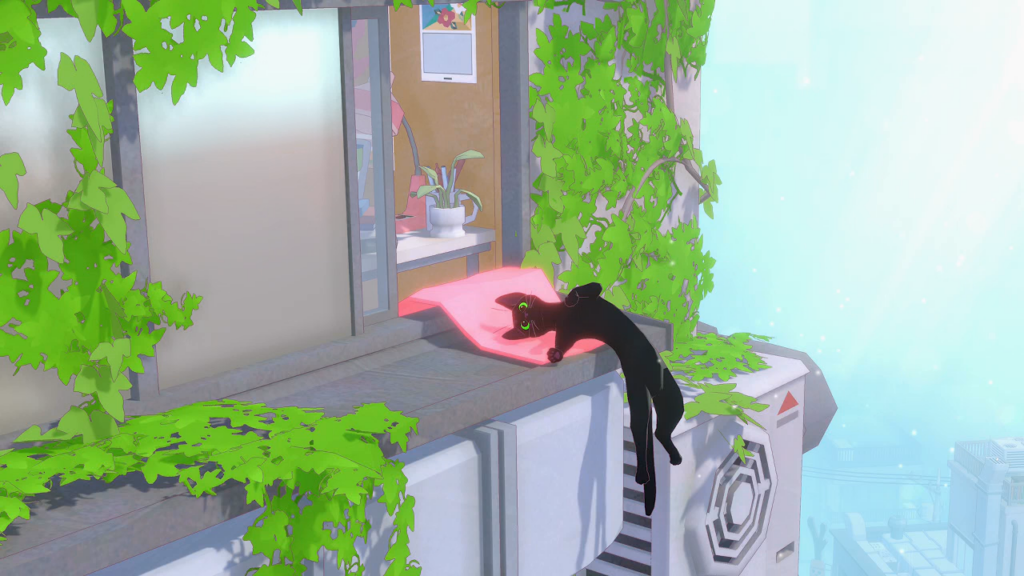
Little Kitty, Big City is a message of adoration for the internet’s favorite temperamental murder snugglers: domestic house cats. Incredible detail is put into the player character’s model which nimbly walks the line between visual fantasy and reality. When the cat stretches, yawns, or ambles up the street, their animations are practically photorealistic, almost certainly made by referencing images and video of real cats. When the cat digs their claws into a wall and gravity drags them futilely downwards, they are animated much more like a cartoon character governed by the laws of slapstick.
The abilities I control through the cat’s avatar are ordinary cat abilities. Each grounds me in the popular idea of what a cat can do. Their prodigious jumping abilities are exploited to create dense 3D platforming environments. Closed doors and gates often block the cat’s path and they must find an alternate route by climbing on discard boxes then along a ventilation duct jutting from a building’s side or through an open window then along the top of a narrow fence. For especially long or precarious jumps, I can hold down the jump button. While the cat crouches in concentration, I aim a targeting reticle that shows the arc their jump will carry them and exactly where they will land once I release the button. Careful use of this precise jumping technique is mandatory for completing many of the city’s most dizzying climbs.
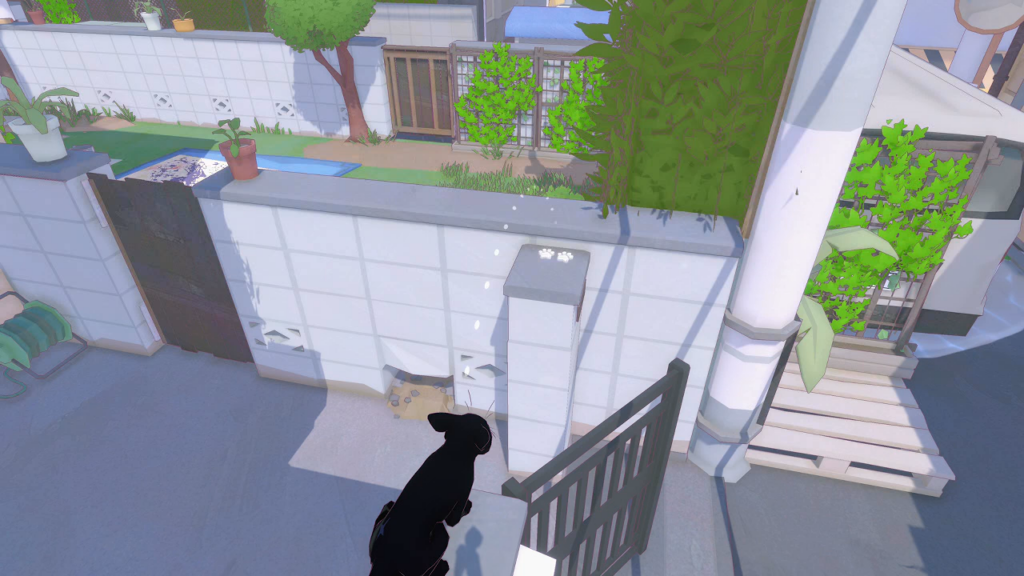
When I want the cat to move faster up a street or along a rooftop, I hold down the zoomies button to turn their stroll into a lope. All other cat powers are relegated to an all-purpose cat button. Pressing it prompts the cat to meow. Holding it brings up a menu of iconic cat emotes like sitting, loafing, making biscuits, and taking a big stretch. The more of the city they explore, the more emotes the cat adds to their repertoire. Few of these abilities have any functional purpose but they add to the complete texture of the character.
The city is set up to be a small sandbox tailored to this idealized portrait of an ordinary cat. Ongoing repairs to a plumbing accident has shut down traffic throughout the city, clearing the streets of dangerous cars. There are still a few other obstacles of which the cat should be wary. An icky puddle beneath their sensitive paws makes the cat recoil, forcing them to find a different path when met with a hose that has been carelessly left running. Scary things like tied up dogs, angry humans, and unexpected zucchinis can make the cat jump and yowl with fright. All these obstacles are only minor setbacks. There is no health meter. There are no extra lives to stockpile. The cat can fall from a rooftop to the street below as many times as they like and suffer no ill effects.
Little Kitty, Big City is not a faithful recreation of the life of a cat. It is not a simulation. It is a pure sandbox adventure filled with activities that emphasize whimsy instead of hardship and camaraderie instead of conflict. It is an embodiment of the chaotic joy that is a cat.
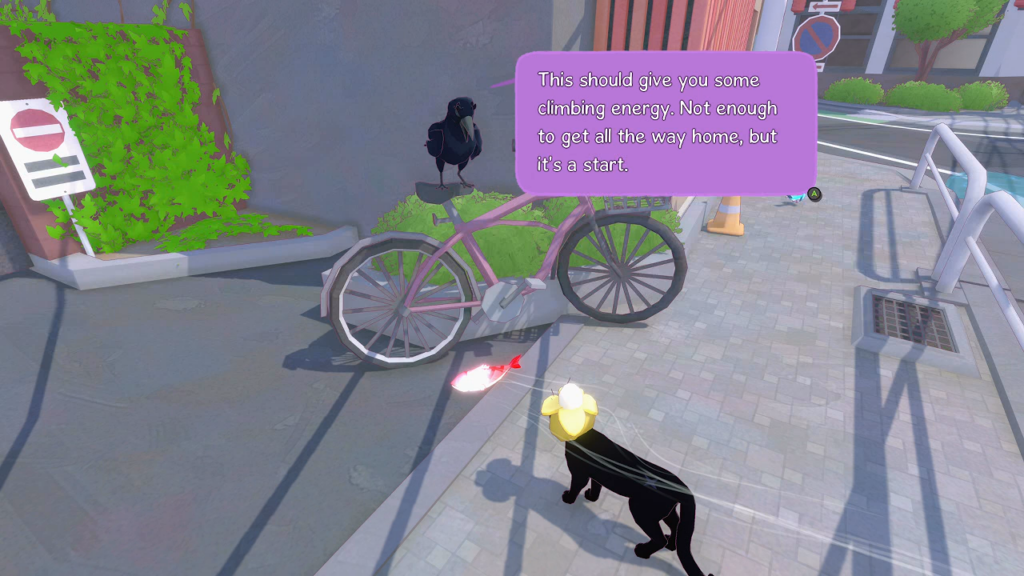
Little Kitty, Big City’s primary goal is to help the cat get back home. This is both straightforward and difficult. Many surfaces around the city, particularly the walls of their human’s apartment building, are covered with vines which the cat can cling to with their claws and clamber up. They do not possess the prowess needed for these climbs at the outset but gain some from every fish they consume. They must eat four fish to reach their maximum climbing potential and there are exactly four fish hidden around the city blocks. Finding these fish and solving the puzzles which give the cat access to them are the real center of the cat’s adventure.
The first of these fish is easy to find. A talkative crow offers to exchange a fish for twenty-five bits of metal called Shinies. This task is offered to the cat soon after they land in the street, following their completion of a brief tutorial area. It’s what really prompts them to leave their first pawprints in the sandbox.

Shinies are found practically everywhere. The cat scoops them up from rough corners between buildings, inside concrete tubes in a construction site, in the ventilation shaft connecting a restroom to a convenience store, and by diving into garbage cans. Their omnipresence encourages the cat to explore every dead end alley and looping path with a curiosity befitting their species. Despite their quantity, Shiny locations are fixed and do not respawn. If I see them scattered across any space, I know the cat has not been there yet, turning them into helpful indicators on which areas of the city remain unexplored.
As the cat finds more of the needed fish and their range expands to the upper levels of the sandbox is when I begin to notice Little Kitty, Big City’s particular problem: The cat sometimes behaves in unexpected ways. Not in the typical way of a cat having a sudden fit that gets five million views when it’s shared on the internet, but in the way of a videogame protagonist. The cat will sometimes clip suddenly through the platform beneath them. At other times their model will flicker, appearing to teleport a short distance away in a completely different pose the videogame has suddenly decided they must occupy.
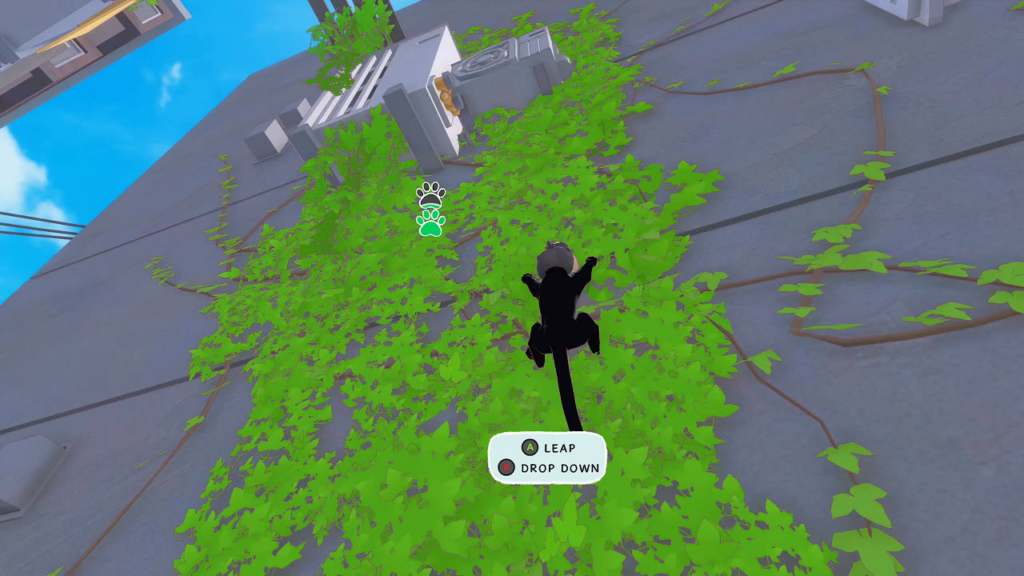
The controls when the cat climbs an ivy wall are a particular issue. I press a direction on the joystick and the cat moves in the opposite. They pull themselves onto a nearby ledge when I don’t want them to but refuse when I need them to. When moving the cat through the more complicated obstacle courses, I learn to distrust the standard jump and always use the aimed jump; even when moving over short gaps, the standard jump results in too many unexpected outcomes. These inconsistencies never interfere with my enjoyment. They do prevent Little Kitty, Big City from being a great 3D platformer in addition to being a great sandbox.
Maximizing the cat’s climbing ability is the apex of their transformative journey. Once they have consumed all four of the city’s fish, there is nowhere they can go and nothing they cannot do. If I keep them focused only on finding the four fish and climbing back to the apartment, Little Kitty, Big City takes me less than two hours to finish. There is much more to do around the city once the cat finds a way to get back home—especially since, now that they know the route, they can come and go as they please.
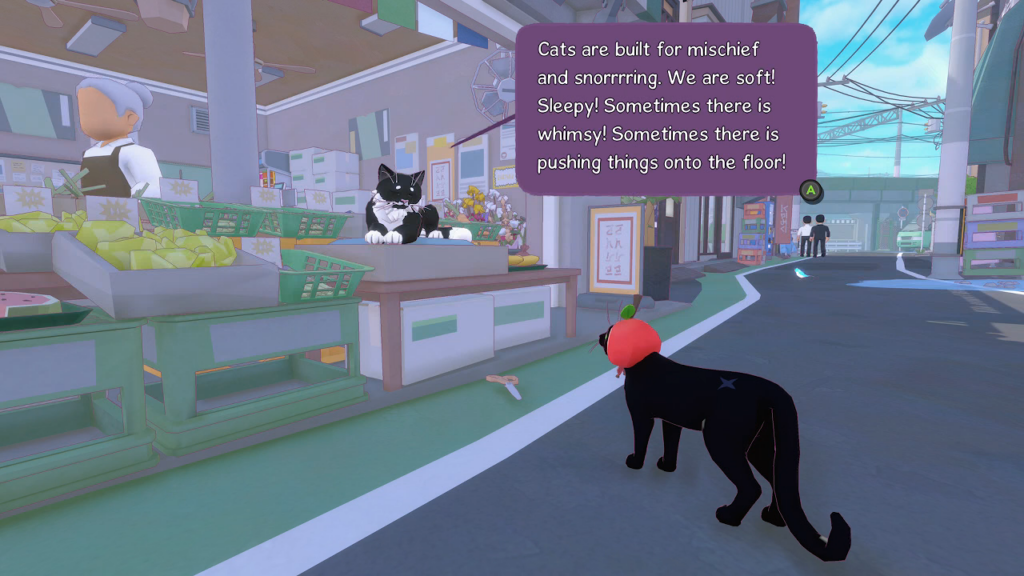
The city is filled with many more animals than just the entrepreneurial crow. A stern orange tabby and a lazy tuxedo cat teach the player character some of the finer points of being a little kitty in the big city. A hapless duck father asks for help rounding up his four lost ducklings. A chameleon leads the cat on a hunt around the city, challenging them to find their next location using humorously incompetent rhymes as hints. A tanuki offers the setting’s only overt example of the supernatural, setting up a fast travel network between manhole covers that sends the cat across the city in seconds through a kaleidoscope of psychedelic colors. The sandbox is so small that I rarely use the network. It never feels needed.
Beyond the main goal and the secondary animal based goals are a long list of tertiary, incidental goals. Called Cat-chievements, these goals often require a repetitive task to be completed many times. Knocking objects from high places, pouncing on the bluebirds that peck at crumbs scattered on the street, and getting pet by passing humans all have individual Cat-chievements. These goals prompt me to engage the cat in more cat-like behavior, adding some authenticity to the portrayal.
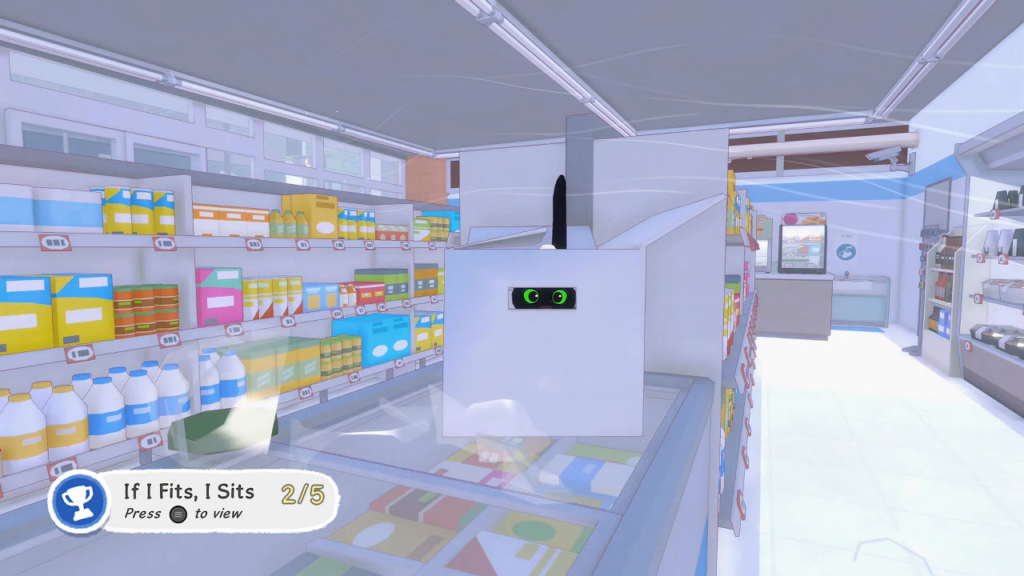
Other Cat-chievements are more specialized and fantastic. The most notable is finding all the hats hidden around the city. Found in capsules, purchased from vending machines (with help from the Crow), or earned for completing animal sidequests, I can equip hats to the cat any time. Options include all manner of fruits and vegetables, devil horns, and even a fishbowl space helmet. Other specialized goals include kicking soccer balls into goals, finding and sitting inside every cardboard box in the city, and diving into every trash can. Instead of encouraging realistic cat behavior, these goals exist to add more fun and fanciful goals.
Not every Cat-chievement is fun to work towards. Delivering one hundred pieces of trash to recycling bins is the worst. Like Shinies, trash is preplaced and finite. Even picking up every scrap around the city leaves the cat well short of the goal. They have to make up the difference by knocking trash out of the hands of passing humans. It’s pure busywork, tedious, and unrewarding. Thankfully there is no real need to finish this or any other Cat-chievement. They are there to chart progress in arbitrary activities. I feel like I’ve seen the breadth of Little Kitty, Big City after seeing the cat back home, helping all the animal friends, and finding all the hats.
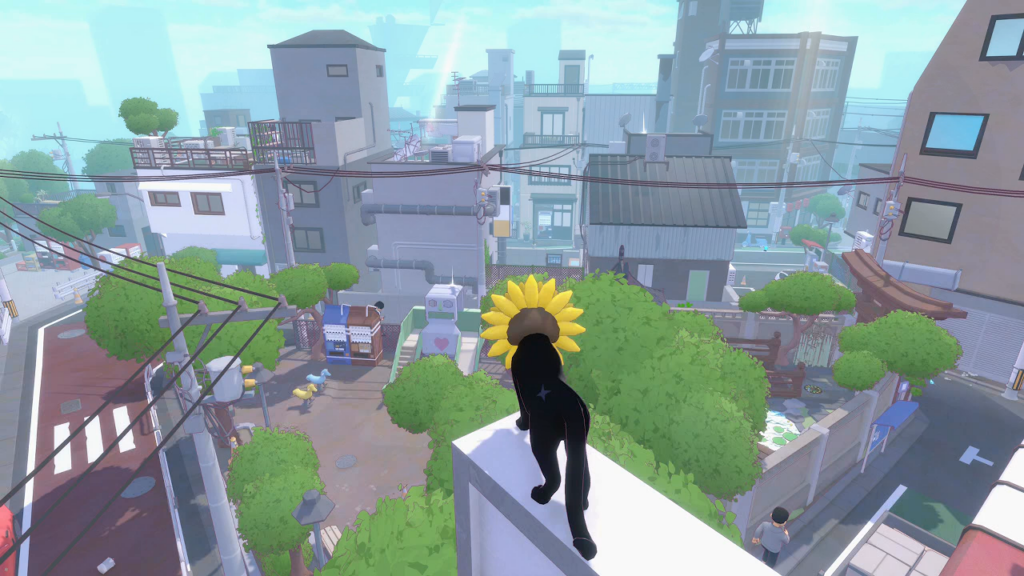
Little Kitty, Big City is a wonderful sandbox adventure. It takes a simple goal—find a way to get back home—and makes that interesting by turning the player character into an unremarkable house cat. Everything it does flows outward from the ramifications of this simple concept. What obstacles might prevent a cat from getting back to their top floor apartment home? What other animals would a cat encounter in an urban city and what help could they provide? What random mischief would a cat get up to in the city? All of these questions are answered with simple, succinct, and engaging activities. At a length of four to five hours to complete most of its goals, Little Kitty, Big City is the kind of unexpected speed bump in my videogaming schedule I cherish. It’s filled with warm feelings and whimsical moments that are not felt in too many other videogames.